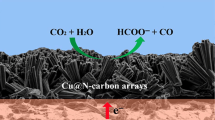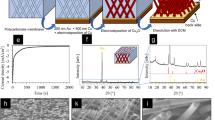Abstract
Nano-forms of copper oxides (CuO and Cu2O) are potential candidates in the field of energy conversion and storage. Low temperature and controlled growth of three-dimensional nanostructured hierarchical assembly of CuO over Cu2O is reported here with demonstrated advantage in energy conversion and storage applications. Electrodeposited Cu2O is partially oxidized in an alkali bath to two different forms of hierarchical nanostructures (HNS): CuO/Cu2O and CuO:Cu(OH)2/Cu2O. Randomly oriented nanorods and nanoflakes with high surface area tussock-like nanostructure are formed during oxidation at room and at elevated temperatures, respectively. The nanoflake morphology exhibits a high surface area of 85.82 m2/g and sufficient ion percolation pathways, leading to an efficient electrode–electrolyte interface for electrochemical energy devices. A favorable conduction and valence band alignment in the HNS with respect to water redox level along with fast electron diffusion time of 0.8 µs make it an ideal photocathode.








Similar content being viewed by others
References
S. Tajik, D.P. Dubal, P. Gomez-Romero, A. Yadegari, A. Rashidi, B. Nasernejad, and A.M. Asiri: Nanostructured mixed transition metal oxides for high performance asymmetric supercapacitors: Facile synthetic strategy. Int. J. Hydrogen Energy 42, 12384 (2017).
Z. Endut, M. Hamdi, and W. Basirun: Pseudocapacitive performance of vertical copper oxide nanoflakes. Thin Solid Films 528, 213 (2013).
D.P. Dubal, G.S. Gund, R. Holze, H.S. Jadhav, C.D. Lokhande, and C-J. Park: Surfactant-assisted morphological tuning of hierarchical CuO thin films for electrochemical supercapacitors. Dalton Trans. 42, 6459 (2013).
G. Wang, L. Zhang, and J. Zhang: A review of electrode materials for electrochemical supercapacitors. Chem. Soc. Rev. 41, 797 (2012).
B. Vidyadharan, I.I. Misnon, J. Ismail, M.M. Yusoff, and R. Jose: High performance asymmetric supercapacitors using electrospun copper oxide nanowires anode. J. Alloys Compd. 633, 22 (2015).
P. Mallick and S. Sahu: Structure, microstructure and optical absorption analysis of CuO nanoparticles synthesized by sol–gel route. Nanosci. Nanotechnol. 2, 71 (2012).
H. Zhu, J. Wang, and G. Xu: Fast synthesis of Cu2O hollow microspheres and their application in DNA biosensor of hepatitis B virus. Cryst. Growth Des. 9, 633 (2008).
X. Zhou, H. Nie, Z. Yao, Y. Dong, Z. Yang, and S. Huang: Facile synthesis of nanospindle-like Cu2O/straight multi-walled carbon nanotube hybrid nanostructures and their application in enzyme-free glucose sensing. Sens. Actuators, B 168, 1 (2012).
J. Zhang, J. Liu, Q. Peng, X. Wang, and Y. Li: Nearly monodisperse Cu2O and CuO nanospheres: Preparation and applications for sensitive gas sensors. Chem. Mater. 18, 867 (2006).
X. Zhang, G. Wang, W. Zhang, Y. Wei, and B. Fang: Fixure-reduce method for the synthesis of Cu2O/MWCNTs nanocomposites and its application as enzyme-free glucose sensor. Biosens. Bioelectron. 24, 3395 (2009).
X. Zhao, Y. Jin, C. Xiang, J. Jin, M. Ding, S. Wu, C. Jia, and L. Sun: Conformal filling of TiO2 nanotubes with dense MxSy films for 3D heterojunctions: The anion effect. ChemElectroChem 6, 1177 (2019).
X. Zhao, J. Huang, Y. Wang, C. Xiang, D. Sun, L. Wu, X. Tang, K. Sun, Z. Zang, and L. Sun: Interdigitated CuS/TiO2 nanotube bulk heterojunctions achieved via ion exchange. Electrochim. Acta 199, 180 (2016).
L. Sun, Y. Huang, M.A. Hossain, K. Li, S. Adams, and Q. Wang: Fabrication of TiO2/CuSCN bulk heterojunctions by profile-controlled electrodeposition. J. Electrochem. Soc. 159, D323 (2012).
M. Kuang, T.T. Li, H. Chen, S.M. Zhang, L.L. Zhang, and Y.X. Zhang: Hierarchical Cu2O/CuO/Co3O4 core–shell nanowires: Synthesis and electrochemical properties Nanotechnology 26, 304002 (2015).
C. Xiang, X. Zhao, L. Tan, J. Ye, S. Wu, S. Zhang, and L. Sun: A solar tube: Efficiently converting sunlight into electricity and heat. Nano Energy 55, 269 (2019).
A. Ulyankina, I. Leontyev, O. Maslova, M. Allix, A. Rakhmatullin, N. Nevzorova, R. Valeev, G. Yalovega, and N. Smirnova: Copper oxides for energy storage application: Novel pulse alternating current synthesis. Mater. Sci. Semicond. Process. 73, 111 (2018).
M. Harilal, B. Vidyadharan, I.I. Misnon, G.M. Anilkumar, A. Lowe, J. Ismail, M.M. Yusoff, and R. Jose: One-dimensional assembly of conductive and capacitive metal oxide electrodes for high-performance asymmetric supercapacitors. ACS Appl. Mater. Interfaces 9, 10730 (2017).
S.K. Shinde, D.P. Dubal, G.S. Ghodake, and V.J. Fulari: Hierarchical 3D-flower-like CuO nanostructure on copper foil for supercapacitors. RSC Adv. 5, 4443 (2015).
G. Navathe, D. Patil, P. Jadhav, D. Awale, A. Teli, S. Bhise, S. Kolekar, M. Karanjkar, J. Kim, and P. Patil: Rapid synthesis of nanostructured copper oxide for electrochemical supercapacitor based on novel [HPMIM][Cl] ionic liquid. J. Electroanal. Chem. 738, 170 (2015).
B. Vidhyadharan, I.I. Misnon, R.A. Aziz, K. Padmasree, M.M. Yusoff, and R. Jose: Superior supercapacitive performance in electrospun copper oxide nanowire electrodes. J. Mater. Chem. A 2, 6578 (2014).
D.P. Dubal, G.S. Gund, C.D. Lokhande, and R. Holze: CuO cauliflowers for supercapacitor application: Novel potentiodynamic deposition. Mater. Res. Bull. 48, 923 (2013).
Y-K. Hsu, Y-C. Chen, and Y-G. Lin: Characteristics and electrochemical performances of lotus-like CuO/Cu (OH)2 hybrid material electrodes. J. Electroanal. Chem. 673, 43 (2012).
R.P. Wijesundera: Electrodeposited Cu2O thin films for fabrication of CuO/Cu2O heterojunction. In Solar Cells-Thin-Film Technologies (InTech, Rijeka, Croatia, 2011); pp. 89–110.
J. Zhang, H. Feng, Q. Qin, G. Zhang, Y. Cui, Z. Chai, and W. Zheng: Interior design of three-dimensional CuO ordered architectures with enhanced performance for supercapacitors. J. Mater. Chem. A 4, 6357 (2016).
C. Li, H. Yamahara, Y. Lee, H. Tabata, and J-J. Delaunay: CuO nanowire/microflower/nanowire modified Cu electrode with enhanced electrochemical performance for non-enzymatic glucose sensing. Nanotechnology 26, 305503 (2015).
G. Fan and F. Li: Effect of sodium borohydride on growth process of controlled flower-like nanostructured Cu2O/CuO films and their hydrophobic property. Chem. Eng. J. 167, 388 (2011).
G.V. Govindaraju, G.P. Wheeler, D. Lee, and K-S. Choi: Methods for electrochemical synthesis and photoelectrochemical characterization for photoelectrodes. Chem. Mater. 29, 355 (2016).
M. Izaki, T. Shinagawa, K-T. Mizuno, Y. Ida, M. Inaba, and A. Tasaka: Electrochemically constructed p-Cu2O/n-ZnO heterojunction diode for photovoltaic device. J. Phys. D: Appl. Phys. 40, 3326 (2007).
W. Zhang, X. Wen, and S. Yang: Controlled reactions on a copper surface: Synthesis and characterization of nanostructured copper compound films. Inorg. Chem. 42, 5005 (2003).
M. Cho, K. Yoon, and B. Song: Dispersion polymerization of acrylamide in aqueous solution of ammonium sulfate: Synthesis and characterization. J. Appl. Polym. Sci. 83, 1397 (2002).
Q. Zhang, K. Zhang, D. Xu, G. Yang, H. Huang, F. Nie, C. Liu, and S. Yang: CuO nanostructures: Synthesis, characterization, growth mechanisms, fundamental properties, and applications. Prog. Mater. Sci. 60, 208 (2014).
M. Dar, Q. Ahsanulhaq, Y. Kim, J. Sohn, W. Kim, and H. Shin: Versatile synthesis of rectangular shaped nanobat-like CuO nanostructures by hydrothermal method; structural properties and growth mechanism. Appl. Surf. Sci. 255, 6279 (2009).
J.Y. Zheng, T-K. Van, A.U. Pawar, C.W. Kim, and Y.S. Kang: One-step transformation of Cu to Cu2O in alkaline solution. RSC Adv. 4, 18616 (2014).
A-m. Cao, J.D. Monnell, C. Matranga, J-m. Wu, L-l. Cao, and D. Gao: Hierarchical nanostructured copper oxide and its application in arsenic removal. J. Phys. Chem. C 111, 18624 (2007).
M. Yin, C-K. Wu, Y. Lou, C. Burda, J.T. Koberstein, Y. Zhu, and S. O’Brien: Copper oxide nanocrystals. J. Am. Chem. Soc. 127, 9506 (2005).
J. Shaikh, R. Pawar, R. Devan, Y. Ma, P. Salvi, S. Kolekar, and P. Patil: Synthesis and characterization of Ru doped CuO thin films for supercapacitor based on Bronsted acidic ionic liquid. Electrochim. Acta 56, 2127 (2011).
D. Skoog, F.J. Holler, and S. Crouch: Principles of Instrumental Analysis (Thomson Brooks Cole, Canada, 2007).
G.A. Carriedo: The use of cyclic voltammetry in the study of the chemistry of metal-carbonyls: An introductory experiment. J. Chem. Educ. 65, 1020 (1988).
P.T. Kissinger and W.R. Heineman: Cyclic voltammetry. J. Chem. Educ. 60, 702 (1983).
J. Liu, J. Wang, C. Xu, H. Jiang, C. Li, L. Zhang, J. Lin, and Z.X. Shen: Advanced energy storage devices: Basic principles, analytical methods, and rational materials design. Adv. Sci. 5, 1700322 (2018).
D. MacArthur: The proton diffusion coefficient for the nickel hydroxide electrode. J. Electrochem. Soc. 117, 729 (1970).
V. Sharma, I. Singh, and A. Chandra: Hollow nanostructures of metal oxides as next generation electrode materials for supercapacitors. Sci. Rep. 8, 1307 (2018).
M.E. Orazem and B. Tribollet: Electrochemical Impedance Spectroscopy (John Wiley & Sons, Inc., Hoboken, New Jersey, 2011).
B-Y. Chang and S-M. Park: Electrochemical impedance spectroscopy. Annu. Rev. Anal. Chem. 3, 207 (2010).
J.R. Macdonald and E. Barsoukov: Impedance Spectroscopy: Theory, Experiment, and Applications History, Vol. 1 (John Wiley & Sons, Inc., Hoboken, New Jersey, 2005); p. 1.
P. Taberna, P. Simon, and J-F. Fauvarque: Electrochemical characteristics and impedance spectroscopy studies of carbon–carbon supercapacitors. J. Electrochem. Soc. 150, A292 (2003).
M. Patel and A. Ray: Evaluation of back contact in spray deposited SnS thin film solar cells by impedance analysis. ACS Appl. Mater. Interfaces 6, 10099 (2014).
M. Morad: An electrochemical study on the inhibiting action of some organic phosphonium compounds on the corrosion of mild steel in aerated acid solutions. Corros. Sci. 42, 1307 (2000).
P. De Jongh, D. Vanmaekelbergh, and J. Kelly: Cu2O: Electrodeposition and characterization. Chem. Mater. 11, 3512 (1999).
F. Marabelli, G. Parravicini, and F. Salghetti-Drioli: Optical gap of CuO. Phys. Rev. B 52, 1433 (1995).
A. Ray, I. Mukhopadhyay, R. Pati, Y. Hattori, U. Prakash, Y. Ishii, and S. Kawasaki: Optimization of photoelectrochemical performance in chemical bath deposited nanostructured CuO. J. Alloys Compd. 695, 3655 (2017).
M. Patel, R. Pati, P. Marathey, J. Kim, I. Mukhopadhyay, and A. Ray: Highly photoactive and photo-stable spray pyrolyzed tenorite CuO thin films for photoelectrochemical energy conversion. J. Electrochem. Soc. 163, H1195 (2016).
A. Paracchino, V. Laporte, K. Sivula, M. Grätzel, and E. Thimsen: Highly active oxide photocathode for photoelectrochemical water reduction. Nat. Mater. 10, 456 (2011).
C. Niveditha, M.J. Fatima, and S. Sindhu: Comprehensive interfacial study of potentio-dynamically synthesized copper oxide thin films for photoelectrochemical applications. J. Electrochem. Soc. 163, H426 (2016).
Z. Zhang and P. Wang: Highly stable copper oxide composite as an effective photocathode for water splitting via a facile electrochemical synthesis strategy. J. Mater. Chem. 22, 2456 (2012).
X. Liu, J. Chen, P. Liu, H. Zhang, G. Li, T. An, and H. Zhao: Controlled growth of CuO/Cu2O hollow microsphere composites as efficient visible-light-active photocatalysts. Appl. Catal., A 521, 34 (2016).
Y-F. Lim, C.S. Chua, C.J.J. Lee, and D. Chi: Sol–gel deposited Cu2O and CuO thin films for photocatalytic water splitting. Phys. Chem. Chem. Phys. 16, 25928 (2014).
D.P. Dubal, G.S. Gund, R. Holze, and C.D. Lokhande: Mild chemical strategy to grow micro-roses and micro-woolen like arranged CuO nanosheets for high performance supercapacitors. J. Power Sources 242, 687 (2013).
P. Marathey, R. Pati, I. Mukhopadhyay, and A. Ray: Effect of annealing temperature on the PEC performance of electrodeposited copper oxides. AIP Conf. Proc. 1961, 030045 (2018).
Acknowledgments
One of the authors (PM) gratefully acknowledges and appreciates the Council of Scientific and Industrial Research (CSIR), New Delhi, for providing financial assistance through Senior Research Fellowship (via Grant Nos. 9/1074 (0001)/2017-EMR-1); Dr. C Balasubramanian, Facilitation Centre for Industrial Plasma Technologies, Institute for Plasma Research, Gandhinagar, for TEM analysis; and the Central Surface Analytical Facility of IIT Bombay for XPS analysis.
Author information
Authors and Affiliations
Corresponding author
Supplementary Material
Rights and permissions
About this article
Cite this article
Marathey, P., Khanna, S., Pati, R. et al. Low temperature–controlled synthesis of hierarchical Cu2O/Cu(OH)2/CuO nanostructures for energy applications. Journal of Materials Research 34, 3173–3185 (2019). https://doi.org/10.1557/jmr.2019.231
Received:
Accepted:
Published:
Issue Date:
DOI: https://doi.org/10.1557/jmr.2019.231




